Types of White Bugs (Including Tiny Bugs): Pictures and Identification
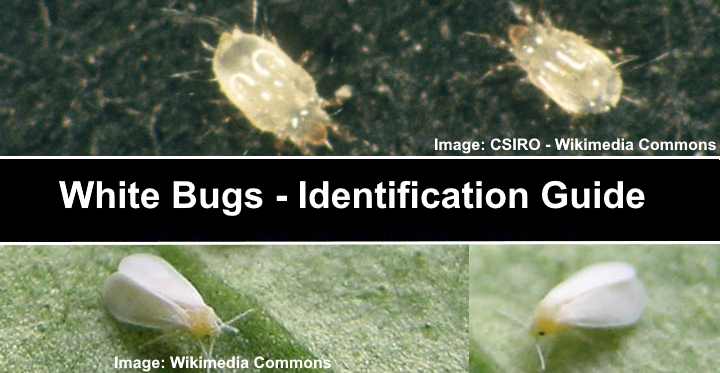
White bugs can be annoying pests in the home. You can often find the pesky bugs in kitchen cabinets, under bathroom sinks, or infesting your houseplants. The problem is that the crawling insects can be challenging to spot and identify. Tiny white bugs like grain mites, flour mites, and mold mites can be less than 0.026” (0.66 mm) long. Other white bugs like termites can do tremendous damage to wooden structures.
Finding a collection of tiny white bugs in your house can be worrying. You want to know what the bug is and if it could cause damage or harm. However, it can be hard to identify them because they are so tiny. You may even need to get a magnifying lens to see the bug’s identifying characteristics.
This article is a comprehensive guide to identifying the most common types of white bugs. You will also find helpful information on getting rid of white bugs from your home.
How to Identify Tiny White Bugs
Identifying little white bugs is challenging because many look similar, and some are even transparent. Ways to identify tiny white bugs include observing their behavior, habitat, and characteristics. For example, do the white bugs fly, crawl, only come out at night, or look like specks of lint or dust?
It’s important to remember that not all white bugs that infest homes are bugs in the scientific term. True bugs are insects in the order Hemiptera and generally include whiteflies and woolly aphids. However, microscopic mites like grain mites may act like bugs, but they are insects in the family Acaridae.
This article refers to all types of annoying white insects that infest homes as bugs — whether they are insects in the Hemiptera order or not.
Types of White Bugs (With Pictures) – Identification
Suppose you have noticed a lot of tiny white bugs that look like dust. In that case, it’s crucial to identify them to know how to eradicate them. Although mites or bugs with white bodies are generally harmless, they can cause allergic reactions to people living in the home.
Let’s look in detail at what that white bug you found in your home could be.
Clothes Moth (Tineola bisselliella)
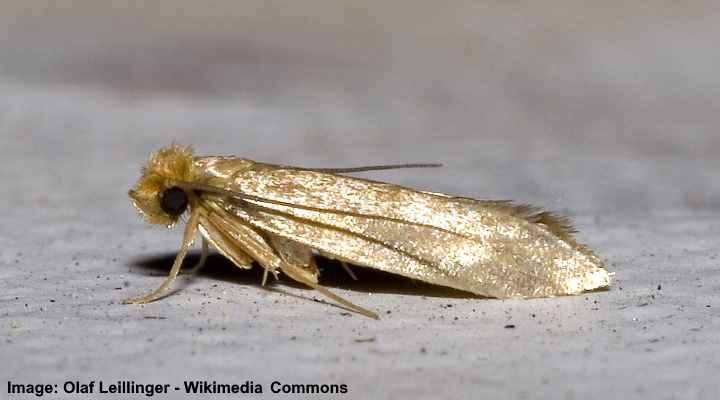
The clothes moth is a little grayish-white bug whose larvae cause damage to natural fabrics
Clothes moths are tiny white pests that can destroy fabrics like silk, wool, leather, and feathers. The small white moth measures 0.28” (7 mm) with a wingspan of 0.35” to 63” (9 – 16 mm). The clothes moth is identified as having grayish-white wings with a light tan-colored body.
The damage caused by clothes moths is typically by their microscopic white larvae. Female moths lay eggs in clusters of up to 200. After the creamy-white caterpillars hatch, they emerge at night to feed on natural fibers. The whitish bugs do so much damage they are considered a serious pest.
You will often find the house moths and their white larvae infesting upholstered furniture. However, you may also find them in dark, undisturbed areas like attics or basements. For example, the first signs of a clothes moth infestation could be holes in sweaters, scarves, blankets, and bed linen.
It’s not uncommon for the destructive white bugs to live in vents and air ducts where the larvae feed on shed pet hair, lint, and other bits of debris and fibers. Because the tiny larvae bugs are so small, getting rid of them for good can be challenging.
How to get rid of white bugs
To prevent further bug damage, it’s vital to get rid of the white bugs at the source. The ways to control clothes moths include laundering infested clothing at hot temperatures, vacuuming floors and carpets, and disposing of heavily infested items.
When eradicating white moth larvae, it’s vital to inspect clothing seams, creases, and folds carefully. Also, check along baseboards, inside closets, and beneath the edges of carpets for evidence of larvae activity. Usually, eliminating the source of the bugs is enough to get rid of them for good.
To prevent white bugs from infesting your home, try to store clothing items and bed linen in tightly fitting bags or containers. Some people successfully use pheromone traps to monitor clothes moth infestations to control them before their numbers become too large.
Termites (Isoptera)
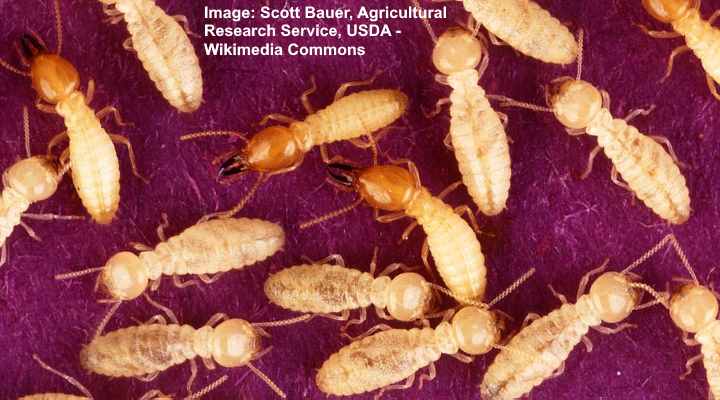
Termites are small creamy white bugs that cause extensive damage to wooden structures
Termites look like white ants and can do tremendous damage to wooden structures. The small creamy-white oval bugs measure 0.15” to 0.6” (4 to 15 mm) long. Termites are identified by their segmented white bodies, bulbous heads, and six legs. Some types of white termites also have wings.
Although they are called white ants, termites are not related to ants. The pesky white bugs do extensive damage to wood and wooden structures. Termites cause severe issues to wooden buildings. This is because the extensive damage they do often goes unnoticed until it’s too late.
There are several signs that white termites are destroying a wooden structure. First, you may notice tiny holes in wood, and frass (termite droppings) in small piles near the holes. Sometimes, you can hear characteristic clicking noises that termites make as they work. Also, knocking on termite-infested timber usually makes a hollow, papery sound.
Have you noticed white ants flying near your house or in your yard? The chances are that these are not flying ants (ants don’t have wings) but swarms of termites looking to set up a new colony.
Getting rid of devastating termites from your home is challenging and often requires professional help. Sometimes, thousands of termites live together in colonies. Therefore, it’s best to prevent them from getting into your home in the first place.
Moisture attracts termites. So, it’s a good idea to ensure your basement or home isn’t too humid, and there are no issues with dampness. Also, fix leaky pipes and seal all cracks in your home’s facade. And you should keep firewood and debris away from your home’s perimeter.
How to get rid of white bugs
To get rid of termites, you can use boric acid, diatomaceous earth, or neem oil.
Boric acid prevents termites from absorbing nutrients and should eventually kill them. You can sprinkle this around the perimeter of your home or wherever you suspect termite activity.
Diatomaceous earth (DE) is a natural, non-toxic insecticide that cuts through a termite’s outer layer, killing them from the outside. So if you suspect termite activity in your basement, you can sprinkle the white power wherever termites may be lurking. To be effective, DE powder needs to be dry.
Making a DIY neem oil solution could help eradicate a small number of termites. One study found that Azadirachta indica in neem oil has a repellent action on termites. Spraying neem oil on wood could help to avert a termite attack.
Related reading: How to make a neem oil insecticide spray.
Booklice / Psocids (Psocoptera)
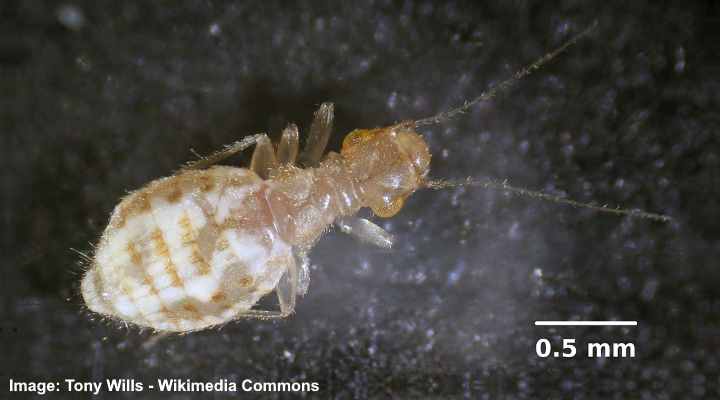
A close up picture of booklouse
Also called psocids, booklice are tiny white bugs that feed on dry, starchy grains, wallpaper glue, and book bindings. The little white “lice” measure 0.04” to 0.08” (1 – 2 mm) long. These tiny winged light brown or white bugs can be found in bathrooms or kitchens.
Booklice are challenging to spot indoors. The most likely places to find the bugs indoors are in book bindings, stored grains, and damp locations, especially if mold is present. Thankfully, the little oval white bugs don’t do damage indoors but are more of a nuisance pest.
How to get rid of white bugs
The best way to get rid of white booklice is to disrupt their habitat. For example, keeping relative humidity below 50 percent can cause the booklice population to dwindle. Also, it would be best if you clean mold from surfaces to avoid attracting the dust-like creatures.
In areas away from food preparation and children, you can dust a layer of diatomaceous earth to help kill off booklice and any other creepy-crawlies you don’t want.
Little White Bugs That Look Like Lint or Dust
If you see little white bugs around your home that resemble lint or dust, there are several possible culprits. It is vitally important to identify whether they are mites, bugs, or flies because control methods vary.
So, if you’ve searched online for “white bugs that look like lint,” please read on to find out how to identify these pests.
Grain or Flour Mites
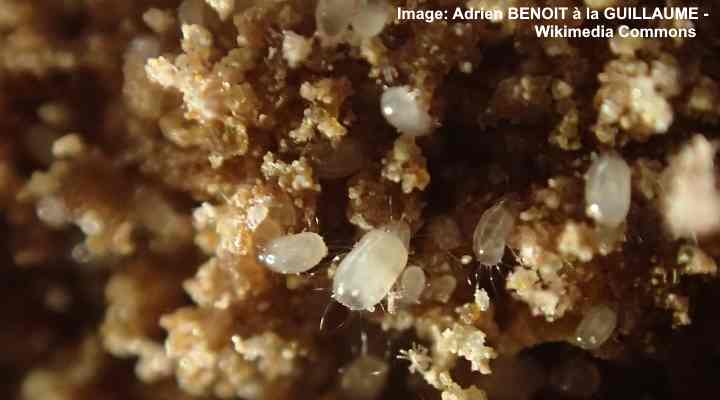
A close up image of Acarus siro, which is a type of grain and flour mite
Common in kitchens, grain mites or flour mites are tiny grayish-white oval-shaped creatures with clawed legs. The tiny smooth-bodied white bugs measure 0.013” to 0.017” (0.33 – 0.43 mm) long. Under a magnifying lens, you’ll notice the bugs have spiny legs and tear-shaped bodies. As the name suggests, these mites are found in stored grains.
Grain mites infest dry, stored food. You may find signs of these white kitchen pests in wheat flour, powdered milk, yeast, cheese, and wheat germ. If the infestation is particularly severe, the grain mites look like a dusting of fine white flour on surfaces.
There are two compelling reasons to remove grain mites from your kitchen. First, the tiny white bugs bite can cause allergic reactions when they bite. Second, they contaminate flour and other dry products, causing food to taste bad or have an unpleasant odor.
How to get rid of white bugs
The only way to get rid of these white creatures that look like dust is to remove the contaminated products. Next, use a vacuum cleaner to remove the tiny bugs. Then wash down all kitchen cabinet shelves and countertops with hot, soapy water.
It’s crucial to avoid attracting grain bugs to your pantry. Therefore, keep flour and dry grains in sealable plastic containers. Also, reducing humidity levels in the kitchen can prevent the white dust-like bugs from reproducing and becoming a nuisance.
Mold Mites (Tyrophagus putrescentiae)
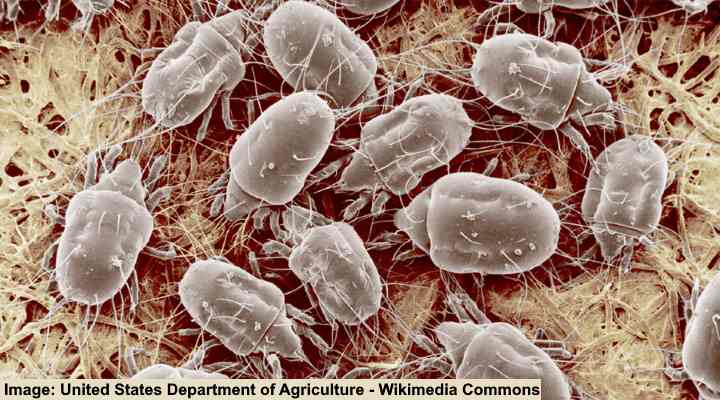
Magnified photo of mold mites (Tyrophagus putrescentiae). These tiny white bugs are visible only when in large numbers
Mold mites are tiny white creatures that are almost impossible to see with the naked eye. The microscopic bugs look like a fine layer of brownish dust on a kitchen surface or pantry shelf when in large groups. The minute pests only measure 0.01” (0.3 mm) long.
Mold mites are common in the kitchen, where the tiny bugs feed on grains, seeds, dried meat, dried eggs, and pet food. These pests also feed on cheese, and their scientific name translates as “cheese eater.” That is why the arthropods are sometimes called cheese mites.
A typical sign of mold mites is grayish dust near food products. The disgusting powdery substance is a collection of live mites, dead mites, shed skin, and fecal matter. Unfortunately, you can only identify the whitish bugs by looking closely with a magnifying lens.
Mold mites also cause allergic skin reactions and respiratory issues in some people.
How to get rid of white bugs
Like controlling other bugs in kitchens, getting rid of mold bugs requires removing contaminated foodstuffs. First, you should sanitize surfaces by wiping them down with hot, soapy water. Then try to identify where the “dusty” mites are feeding and dispose of tainted products. In addition, reducing humidity in the kitchen or pantry can keep the pantry bugs away from your home.
Woolly Aphids (Eriosomatinae)
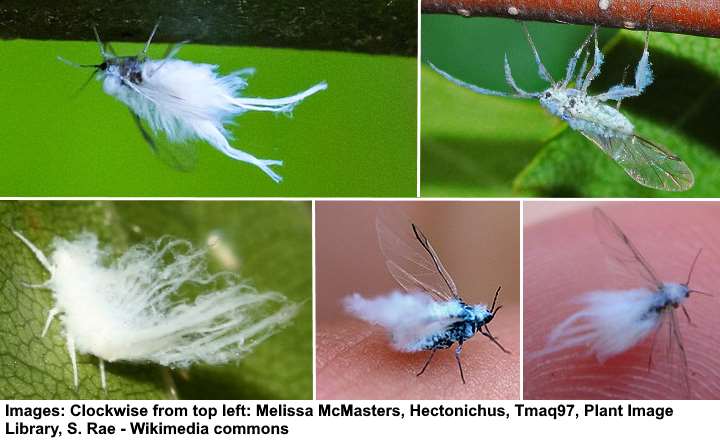
Close up images of various types of woolly aphids
Woolly aphids are sap-sucking, plant-destroying white pests that can infest houseplants. The crawling insects look like tiny lint pieces and are found in cottony masses under leaves. The fuzzy white bugs measure 0.4” to 0.27” (1 to 7 mm) long, have a furry-looking body, and have tiny translucent wings.
Woolly aphids tend only to affect fruit trees in your garden. However, other types of aphids — white aphids, brown aphids, black aphids, and green aphids — can commonly infect houseplants. Aphid damage on houseplants and ornamental garden plants can result in deformed foliage, leaf spot, and weakened plant health.
How to get rid of white bugs
To get rid of any species of white aphid from your houseplants, use a neem oil solution. Make this by mixing two teaspoons neem oil, a teaspoon of Castile liquid soap, and a quart (1 l) of water. Mix thoroughly in a spray bottle and spray affected houseplant foliage once a week to eliminate the white bugs.
Mealybugs (Pseudococcidae)
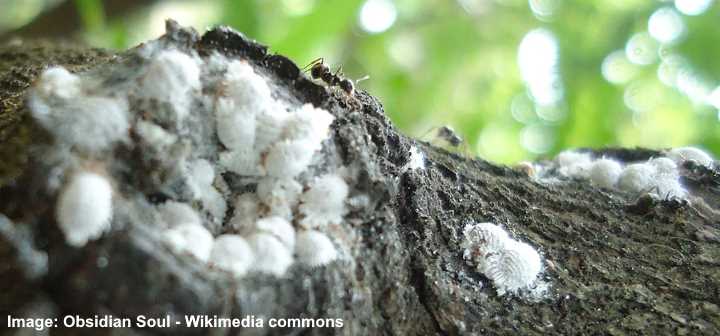
Mealybugs look like small oval white fuzzy bugs on plant leaves and stems
Mealybugs look like little bits of white cotton with legs crawling on houseplants. The white pests have a distinct fuzzy body with three pairs of legs, a small pair of antennae, and sometimes a few wax filaments protruding from the body. Mealybugs are tiny white soft-bodied pests measuring 0.05” to 0.2” (1.3 – 5 mm).
Suppose you’ve noticed white fuzzy stuff or cottony masses on plant leaves and stems. In that case, the chances are that you must get rid of mealybugs. The white pests also leave a waxy residue under leaves and on stems. Their feeding causes the plants to become weak and stunted with yellowed foliage.
How to get rid of white bugs
Make a homemade spray to eradicate white mealybugs by mixing a cup of rubbing alcohol with a quart (1 l) of water. Then, spray the solution directly on the fuzzy white bugs to kill them on contact. Repeat weekly until all signs of mealybugs have gone for good.
Whiteflies
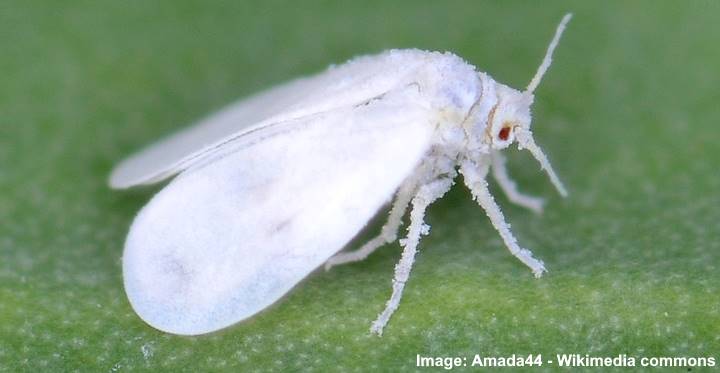
A close up picture of a whitefly
Whiteflies are small flying white insects resembling tiny moths. The pesky flying bugs typically swarm around host plants in your home or greenhouse. Tiny whiteflies are destructive plant pests, feeding on the sap of plants and excreting a sticky honeydew substance that causes sooty mold. Whiteflies measure 0.4” to 0.8” (1 – 2 mm) long.
Like all types of true bugs, whiteflies bite plant foliage and stems to suck the juices. This can damage plants by weakening their growth or spreading plant diseases. Failure to get rid of a whitefly infestation could result in plant death.
How to get rid of white bugs
To eliminate whiteflies from plants, make a soapy insecticidal solution by mixing a tablespoon of mild dish soap with a quart (1 l) of water. Next, dip a soft cloth in the solution and wipe down all leaves and stems to remove the white bugs and kill them. Repeat every three days to kill the bugs.
What are White Bugs in the Bathroom?
White bugs you find lurking under the bathtub or in damp bathrooms are typically those attracted to damp places. The tiny, teeny microscopic bugs could be mold mites, silverfish, or even booklice. Regularly cleaning in cracks and crevices, scrubbing away debris from between tiles, and eliminating dripping taps can keep bugs out of your bathroom.
White Bugs in the Kitchen
Many types of white bugs are attracted to kitchens and pantries because they feed on starchy grains. In addition, the warm, humid environment of a kitchen encourages tiny white bugs to multiply. Keeping dry food products in sealable containers can help prevent bug infestations in kitchens.
White Bugs on Houseplants
Common white pests on houseplants are mealybugs, woolly aphids, and whiteflies. Usually, applying a neem oil spray once a week is enough to control and prevent white bug infestations on the plant growing in your home.
White Mites: Identification, Treatment and Prevention of White Spider Mite Damage
Related articles:
- Small Black Bugs – Identification
- Small House Bugs – Identification
- Small Brown Bugs – Identification
